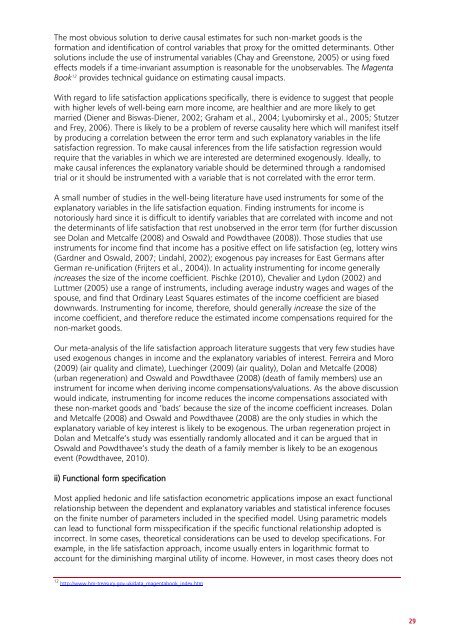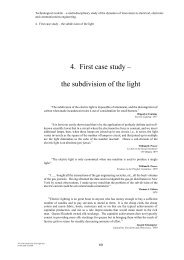Valuation Techniques for Social Cost-Benefit Analysis: - HM Treasury
Valuation Techniques for Social Cost-Benefit Analysis: - HM Treasury
Valuation Techniques for Social Cost-Benefit Analysis: - HM Treasury
Create successful ePaper yourself
Turn your PDF publications into a flip-book with our unique Google optimized e-Paper software.
The most obvious solution to derive causal estimates <strong>for</strong> such non-market goods is the<br />
<strong>for</strong>mation and identification of control variables that proxy <strong>for</strong> the omitted determinants. Other<br />
solutions include the use of instrumental variables (Chay and Greenstone, 2005) or using fixed<br />
effects models if a time-invariant assumption is reasonable <strong>for</strong> the unobservables. The Magenta<br />
Book 12 provides technical guidance on estimating causal impacts.<br />
With regard to life satisfaction applications specifically, there is evidence to suggest that people<br />
with higher levels of well-being earn more income, are healthier and are more likely to get<br />
married (Diener and Biswas-Diener, 2002; Graham et al., 2004; Lyubomirsky et al., 2005; Stutzer<br />
and Frey, 2006). There is likely to be a problem of reverse causality here which will manifest itself<br />
by producing a correlation between the error term and such explanatory variables in the life<br />
satisfaction regression. To make causal inferences from the life satisfaction regression would<br />
require that the variables in which we are interested are determined exogenously. Ideally, to<br />
make causal inferences the explanatory variable should be determined through a randomised<br />
trial or it should be instrumented with a variable that is not correlated with the error term.<br />
A small number of studies in the well-being literature have used instruments <strong>for</strong> some of the<br />
explanatory variables in the life satisfaction equation. Finding instruments <strong>for</strong> income is<br />
notoriously hard since it is difficult to identify variables that are correlated with income and not<br />
the determinants of life satisfaction that rest unobserved in the error term (<strong>for</strong> further discussion<br />
see Dolan and Metcalfe (2008) and Oswald and Powdthavee (2008)). Those studies that use<br />
instruments <strong>for</strong> income find that income has a positive effect on life satisfaction (eg, lottery wins<br />
(Gardner and Oswald, 2007; Lindahl, 2002); exogenous pay increases <strong>for</strong> East Germans after<br />
German re-unification (Frijters et al., 2004)). In actuality instrumenting <strong>for</strong> income generally<br />
increases the size of the income coefficient. Pischke (2010), Chevalier and Lydon (2002) and<br />
Luttmer (2005) use a range of instruments, including average industry wages and wages of the<br />
spouse, and find that Ordinary Least Squares estimates of the income coefficient are biased<br />
downwards. Instrumenting <strong>for</strong> income, there<strong>for</strong>e, should generally increase the size of the<br />
income coefficient, and there<strong>for</strong>e reduce the estimated income compensations required <strong>for</strong> the<br />
non-market goods.<br />
Our meta-analysis of the life satisfaction approach literature suggests that very few studies have<br />
used exogenous changes in income and the explanatory variables of interest. Ferreira and Moro<br />
(2009) (air quality and climate), Luechinger (2009) (air quality), Dolan and Metcalfe (2008)<br />
(urban regeneration) and Oswald and Powdthavee (2008) (death of family members) use an<br />
instrument <strong>for</strong> income when deriving income compensations/valuations. As the above discussion<br />
would indicate, instrumenting <strong>for</strong> income reduces the income compensations associated with<br />
these non-market goods and ‗bads‘ because the size of the income coefficient increases. Dolan<br />
and Metcalfe (2008) and Oswald and Powdthavee (2008) are the only studies in which the<br />
explanatory variable of key interest is likely to be exogenous. The urban regeneration project in<br />
Dolan and Metcalfe‘s study was essentially randomly allocated and it can be argued that in<br />
Oswald and Powdthavee‘s study the death of a family member is likely to be an exogenous<br />
event (Powdthavee, 2010).<br />
ii) Functional <strong>for</strong>m specification<br />
Most applied hedonic and life satisfaction econometric applications impose an exact functional<br />
relationship between the dependent and explanatory variables and statistical inference focuses<br />
on the finite number of parameters included in the specified model. Using parametric models<br />
can lead to functional <strong>for</strong>m misspecification if the specific functional relationship adopted is<br />
incorrect. In some cases, theoretical considerations can be used to develop specifications. For<br />
example, in the life satisfaction approach, income usually enters in logarithmic <strong>for</strong>mat to<br />
account <strong>for</strong> the diminishing marginal utility of income. However, in most cases theory does not<br />
12 http://www.hm-treasury.gov.uk/data_magentabook_index.htm<br />
29





![AIRTO [Professor Dr Brian Blunden] - HM Treasury](https://img.yumpu.com/15492848/1/184x260/airto-professor-dr-brian-blunden-hm-treasury.jpg?quality=85)










